Tokay Geckos (Gekko gecko) are a formidable species of large, arboreal lizards belonging to the family Gekkonidae within the order Squamata, distinguished by their robust physique and vibrant coloration. As one of the largest gecko species, adult males can reach lengths of up to 20 inches (51 cm) and weigh as much as 14 oz (400 g), while females are slightly smaller, making them a significant presence in their native habitats across Southeast and East Asia (1, 14, 2). Despite their extensive geographic distribution and adaptability to both rainforests and human-dominated environments, the species faces conservation challenges due to unsustainable trade, prompting a debate over its current IUCN status of “Least Concern” (1, 12, 15).
This comprehensive guide delves into the fascinating world of the Tokay Gecko, exploring its intricate morphological adaptations for climbing and defense, its complex behavioral ecology including territorial vocalizations and hunting strategies, and its unique ecological role within natural and urban ecosystems. Through an examination of its biological characteristics and interactions with humans, this article aims to provide a definitive resource for understanding this remarkable reptile. How do their specialized toe pads enable them to defy gravity, and what does their distinct call truly signify?
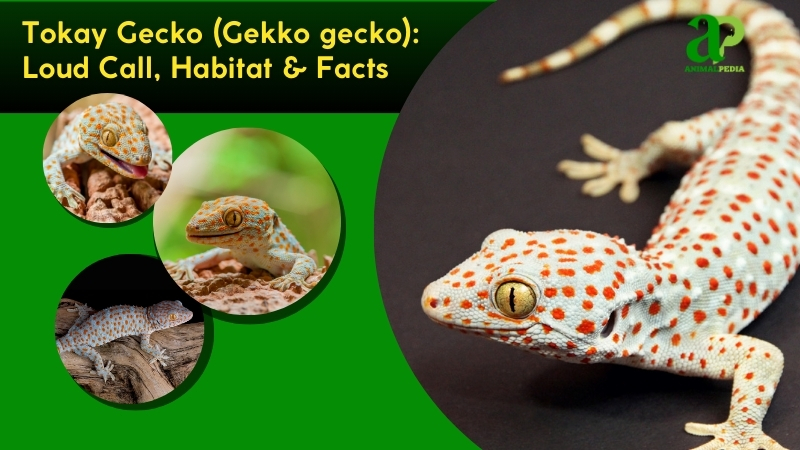
What are Tokay Geckos?
Tokay Geckos are a type of large, nocturnal, and arboreal lizard native to Southeast and East Asia, recognized by their distinctive loud call and highly aggressive temperament (10, 21). These animals occupy a crucial ecological niche as predators, primarily consuming insects but also preying on small vertebrates like rodents and other lizards, a key aspect of their biological role that directly influences local food webs (14). While their widespread distribution leads the IUCN Red List to classify them as “Least Concern,” this status is widely debated among conservationists due to evidence of significant population declines, with recent studies in areas like Assam, India, highlighting threats from illegal poaching for traditional medicine and the exotic pet trade (1, 12, 15). This demonstrates that the perception of their abundance does not always align with localized conservation realities.
Taxonomically, the Tokay Gecko (Gekko gecko) is a member of the family Gekkonidae, which places it among the more than 2,000 species of geckos worldwide, an order of scaled reptiles known as Squamata (13). This classification, under the Class Reptilia and Phylum Chordata, underscores its position within the vertebrate lineage. Beyond its scientific nomenclature, the species is known by various local names that often reflect its vocalizations, including Tuko in the Philippines and Tokek in Indonesia, serving as a testament to the animal’s cultural integration and auditory impact across its native range (4, 21). Having a clearer understanding of their place in the animal kingdom, it’s now time to dive into what makes them so visually striking. The next section will reveal the unique physical features and specialized structures that define their incredible abilities.
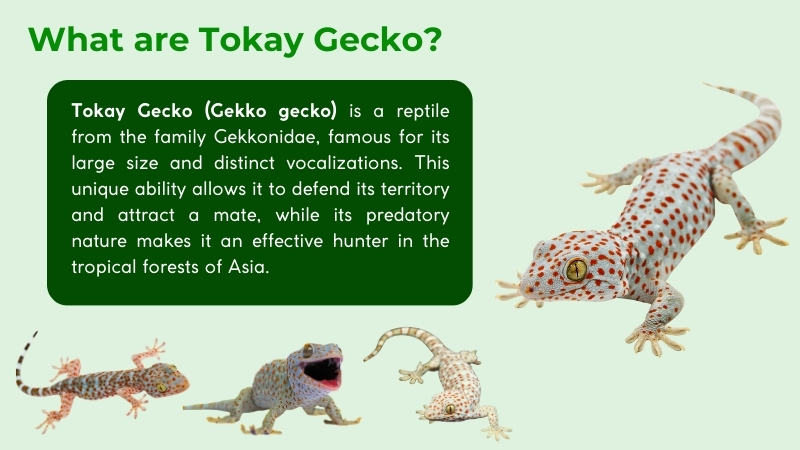
What Do Tokay Geckos Look Like?
The Tokay Gecko presents a striking appearance, possessing a robust and cylindrical, yet slightly flattened body that is well-suited for its arboreal lifestyle (2). Its most notable feature is its vivid coloration and skin texture, which typically consists of a grayish or bluish body adorned with bright orange, red, or yellow spots that function as effective camouflage against tree bark. The species exhibits a remarkable physiological ability to lighten or darken its skin tone to better blend into its surroundings, a trait that enhances its cryptic nature year-round (10). This vibrant aesthetic is a key aspect of their identity and a primary reason for their popularity within the pet trade.
- Adhesive Toe Pads: The Tokay Gecko’s anatomy is defined by several distinctive morphological adaptations that facilitate its survival, with its adhesive toe pads being paramount. Each foot contains approximately 500,000 microscopic hairs known as setae, which are further divided into billions of spatula-like tips, generating enough van der Waals force to allow the gecko to cling effortlessly to vertical and inverted surfaces (18).
- Powerful Jaws and Regenerative Teeth: The gecko possesses a formidable array of up to 100 sharp teeth per jaw half, which are designed for grasping insect prey (14). A remarkable feature of its dentition is that, like sharks, its teeth are replaced continuously throughout its life, ensuring a perpetual ability to grasp and secure its meals.
- Defensive Mouth and Vocalizations: The mouth’s interior is a striking dark black with bright pink lips, which are used in defensive displays to startle predators. When threatened, the gecko will open its jaws in a sudden, surprising threat display, often accompanied by a loud hissing or barking sound to deter potential predators (4).
- Semi-Prehensile Tail and Autotomy: The species’ robust, semi-prehensile tail serves as a vital tool for balance and grasping, but it is also a critical defense mechanism, capable of being deliberately detached from the body to distract predators through a process called autotomy (10).
- Distinctive Eyes: Its large, prominent eyes, which feature transparent fused eyelids cleaned by a lick of the tongue, are equipped with vertical slit pupils, giving the gecko exceptional nocturnal vision (4, 20).
Sexual dimorphism is also a key feature of the species’ physical identity, with males being noticeably larger and heavier than females, often displaying more vibrant and brighter coloration (1). This visual distinction is further emphasized by the presence of prominent femoral pores and hemipenal bulges in males, features that are absent or less pronounced in females, providing a clear external marker for sex identification. The unique blend of their robust size, brilliant patterns, and specialized physical structures makes the Tokay Gecko a truly fascinating subject. With such an impressive appearance, it’s natural to wonder just how large these remarkable creatures can grow.
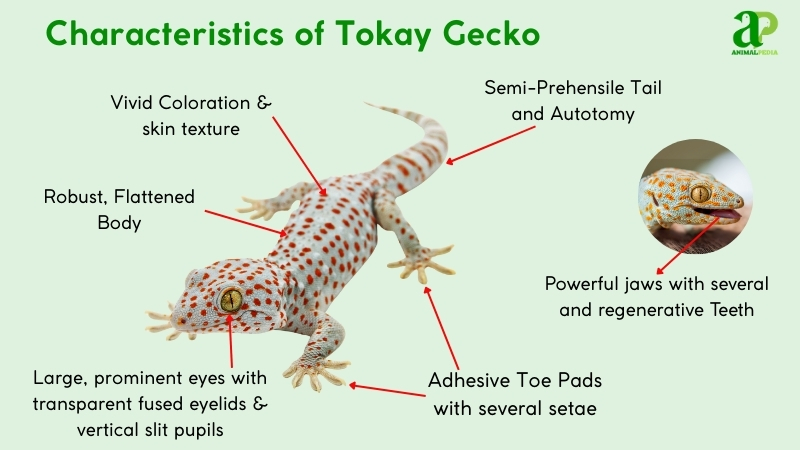
How Big Are Tokay Geckos?
The Tokay Gecko is one of the largest gecko species in the world, with adults typically ranging from 12 to 14 inches (30-36 cm) in length (19). However, exceptional individuals, particularly captive males, can grow to be much larger (2). When comparing growth stages, a hatchling is minuscule, measuring only about 2-3 inches (5-8 cm), while juveniles rapidly grow into their formidable adult size, often reaching sexual maturity around one year of age (11). In terms of size comparison, a fully grown male Tokay Gecko is roughly the length of a standard 12-inch school ruler, emphasizing its impressive stature (19).
| Males | Females | |
| Length | 12 – 20 inches (30 – 51 cm) | 8 – 14 inches (20 – 36 cm) |
| Weight | 5 – 14 oz (140 – 400 g) | 3 – 7 oz (85 – 200 g) |
| Record Size | 24 inches (61 cm) | 16 inches (41 cm) |
As you can see, their impressive size is a key part of their identity. This formidable stature is matched only by their ability to thrive in a surprisingly vast and diverse range of habitats across Asia.
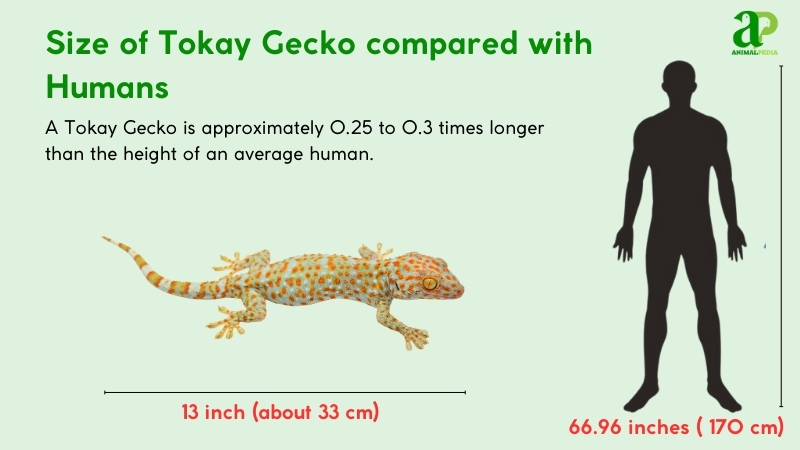
Where Do Tokay Geckos Live?
Tokay Geckos are indigenous to a vast region of Southeast and East Asia, from northeastern India and Nepal eastward through the Malay Archipelago and Indonesia, extending as far north as China (2, 21). These highly adaptive arboreal reptiles thrive in diverse environments, ranging from primary tropical rainforests and secondary forests to human-dominated habitats like rural villages and urban areas where they often take up residence in buildings (12, 15). This close proximity to humans is a defining characteristic of the species, as they are frequently found on walls, ceilings, and in crevices of homes, capitalizing on stable temperatures and abundant prey (14).
This Tokay Geckos species exhibits strong territorial behavior, with males actively defending their domains against other geckos, particularly rivals, through their distinctive loud vocalizations and aggressive posturing (10). The iconic “Tokay” call serves as a crucial signal for territory defense and attracting mates. Their preference for vertical structures, from trees to buildings, allows them to maintain a clear line of sight and an advantage over competitors within their claimed habitat. The Tokay Gecko’s unique habitat preferences are intrinsically linked to their complex and often misunderstood behavior. By understanding where they live, we can begin to uncover the secrets of how they interact with their world.
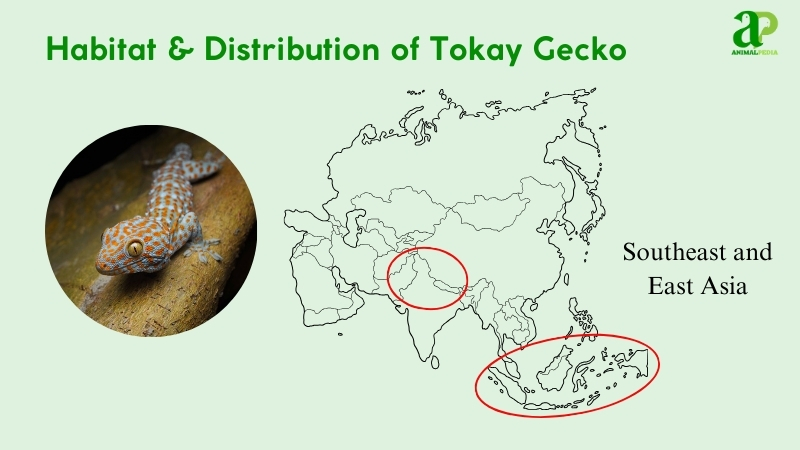
How Do Tokay Geckos Behave?
The Tokay Gecko is characterized by its highly territorial and aggressive disposition, a complex set of behaviors that govern its daily interactions, feeding strategies, and reproductive cycles.
- As an opportunistic carnivore, it is a stealthy hunter, ambushing a wide range of insects and small vertebrates with a powerful bite.
- Its movement is a masterful display of arboreal athleticism, utilizing specialized toe pads and a prehensile tail for climbing and precision leaps (17).
- Primarily nocturnal, its activity is cued by the cycles of dusk and dawn, with seasonal changes impacting its feeding and reproductive intensity (9).
The gecko’s territorial nature and hunting prowess are truly impressive. To get a better grasp of its place in the food web, we’ll start by exploring its unique diet and feeding patterns.
Diet and Feeding
Tokay Geckos are carnivorous predators, a dietary classification defined by their reliance on animal-based protein (14). The majority of its diet consists of various insects, including roaches and crickets, but it will opportunistically consume smaller vertebrates such as mice, small birds, and other lizards (7, 14). Its hunting behavior is primarily sit-and-wait predation; the gecko remains stationary and camouflaged, patiently awaiting its prey before launching a sudden, rapid strike with its powerful jaws (7).
These Tokay Geckos are known for their voracious appetites, and their highly efficient metabolic rate allows them to consume large meals relative to their body size (18). The Tokay Gecko’s powerful bite force, which is exceptionally strong for its size, ensures a firm grasp on struggling prey, while its continuously replaced teeth prevent loss of function from wear and tear (14).
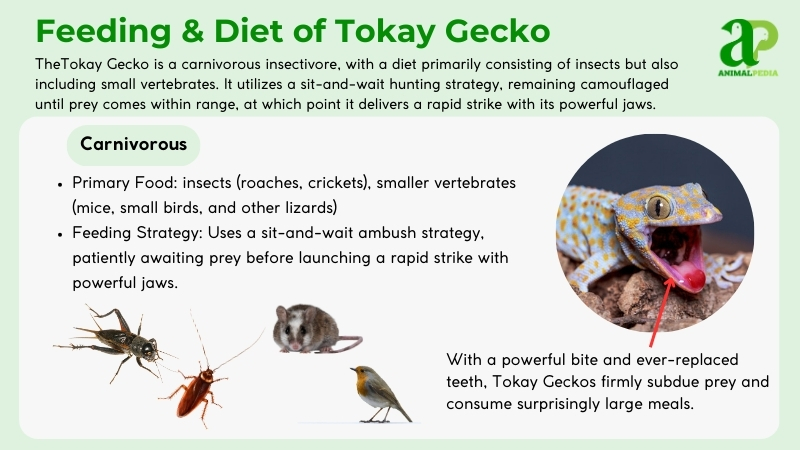
Movement and Abilities
Tokay Geckos move with a masterful combination of climbing, crawling, and leaping, movements that are critically enabled by their specialized morphological adaptations (17). They are highly agile climbers, capable of navigating vertical and inverted surfaces with remarkable speed due to their adhesive lamellae (17). Their movements are often a blend of deliberate, cautious crawling and explosive, agile leaps between branches or walls (17).
The Tokay Geckos exhibits remarkable bursts of speed, with anecdotal evidence suggesting they can move at surprising velocities when pursuing prey or escaping a threat. Their most impressive ability is the powerful adhesion of their toe pads, a physical capability driven by van der Waals forces at a microscopic level, enabling them to defy gravity (18). This incredible grip allows them to walk on ceilings and glass without difficulty (18).

Daily/Seasonal Patterns
Tokay Geckos are fundamentally nocturnal, becoming active as dusk sets in and retreating to their shelter at dawn (9). Their daily activity cycle begins in the late evening, around 6 PM, when they emerge from their daytime hiding places to begin foraging. Peak hunting and vocalization often occurs between 9 PM and 2 AM, a period of intense activity that subsides as morning approaches (9).
While active year-round in tropical climates, their behavior is subtly influenced by seasonal shifts. During breeding season, male vocalizations and territorial disputes become more frequent and intense (14). The species does not exhibit long-distance migration (2). Their movements are typically limited to their established territories, and they are known to maintain a home range that can be consistently used for many months or even years (12).
By understanding their daily habits and seasonal routines, we can now turn our attention to the fascinating and often surprising details of their reproductive cycle.
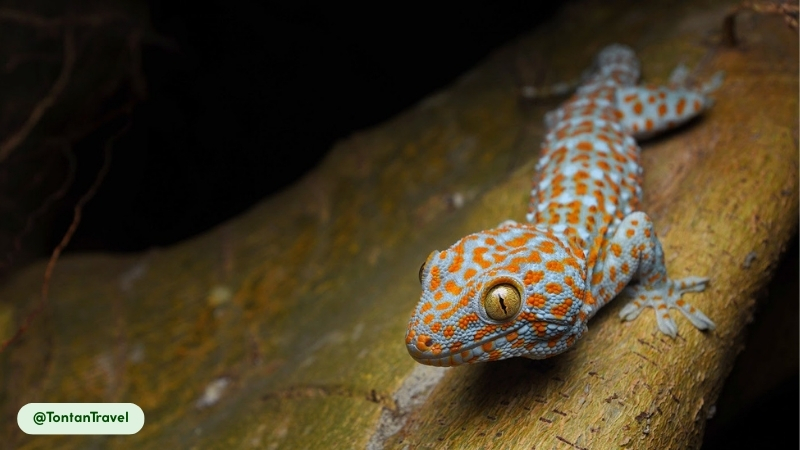
How Do Tokay Geckos Reproduce?
Tokay Geckos are oviparous, a reproductive method defined by laying eggs (11). The mating season typically aligns with the warmer, wetter months, which provide favorable conditions for breeding and hatchling development (2). During this period, male Tokay Geckos initiate courtship with a series of loud, distinctive vocalizations that serve to attract females and establish their territorial dominance (14). These calls, often a repeated “to-kay” sound, are a key component of their reproductive display, signaling both availability and genetic fitness.
After a successful mating, a gravid female will seek out a secure, concealed location, such as a tree hollow or a crevice in a wall, to deposit her clutch of eggs (9). Each clutch typically consists of one or two hard-shelled eggs, which are often laid in pairs and adhere to the substrate (9, 11). The female may lay several clutches throughout the breeding season (11). The incubation period for the eggs lasts approximately 100 to 120 days, though this can vary depending on ambient temperatures and humidity (9). Hatchlings emerge fully independent, as Tokay Geckos do not exhibit parental care after the eggs have been laid.
The reproductive cycle of the Tokay Gecko is a vital part of its life, but it’s only one aspect of its journey. Now, we’ll examine their remarkable longevity and what factors influence how long they live.
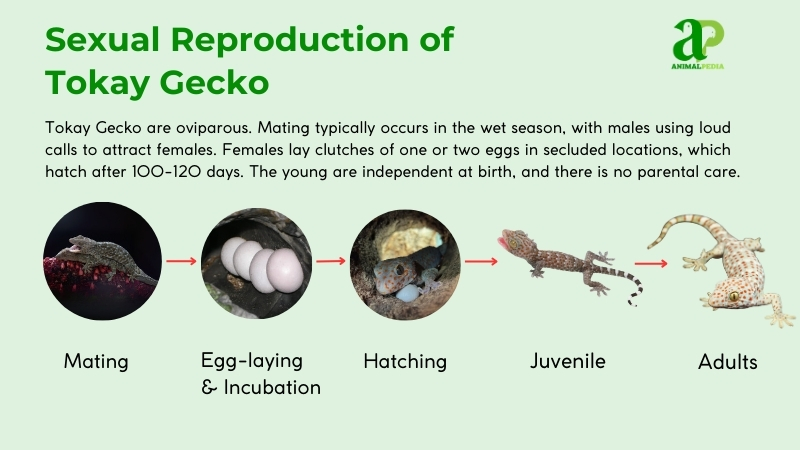
How Long Do Tokay Geckos Live?
Tokay Geckos live approximately 15 to 20 years on average in captivity, a lifespan that is significantly longer than their wild counterparts, which typically live up to 10 years due to environmental pressures and predation (1, 11). The species reaches sexual maturity at a relatively young age, often around one year old, allowing them to contribute to the population early in their life cycle (11).
Several key factors influence the longevity of this species. In the wild, their survival is challenged by factors such as the scarcity of food, threats from predators, and the impact of human activities, particularly habitat loss and the illegal pet trade (12, 15). In contrast, captive-bred geckos benefit from consistent, high-quality nutrition, a controlled environment, and veterinary care, which collectively mitigate many of the risks that reduce the lifespan of geckos in their native habitats.
Their impressive lifespan often prompts questions about their interaction with humans. Knowing that they can live for so long, it’s important to understand how they are both beneficial and, at times, harmful to us.
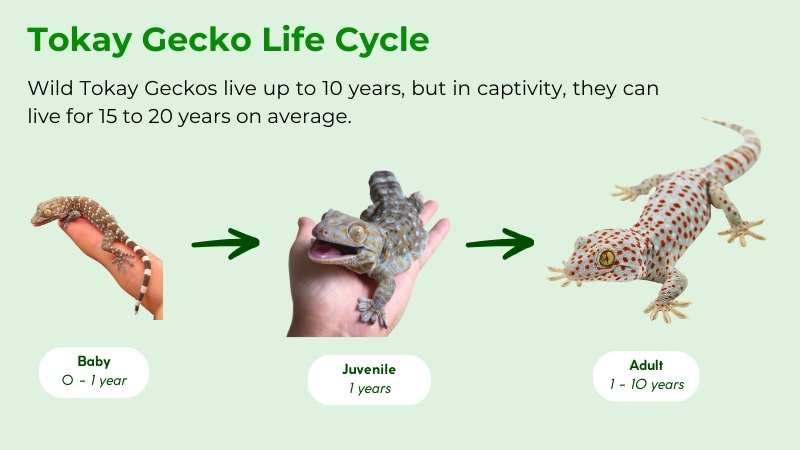
Are Tokay Geckos Harmful/ Beneficial to Humans?
Tokay Geckos are generally beneficial to humans, primarily due to their role as natural pest control agents (14). They consume a wide variety of insects, including roaches and spiders, which helps to maintain local insect populations in check, a significant benefit in both rural and urban environments where they often reside (14). This predatory behavior reduces the need for chemical insecticides, representing an environmentally friendly solution to pest management.
Although generally beneficial, Tokay Geckos can be perceived as harmful due to their aggressive defensive behaviors, though they are not venomous (1). When threatened, they will open their jaws in a startling display and may bite, delivering a powerful bite that can break the skin and cause pain (14, 18). These encounters are typically a result of the gecko feeling cornered or handled improperly, and their bite is not a malicious act but a purely defensive one. Therefore, the recommended guideline for human interaction is to avoid handling them and to give them space when encountered (18).
The ways in which Tokay Geckos impact humans are a critical aspect of their overall conservation status. Next, we’ll explore their current standing and what this means for their future.
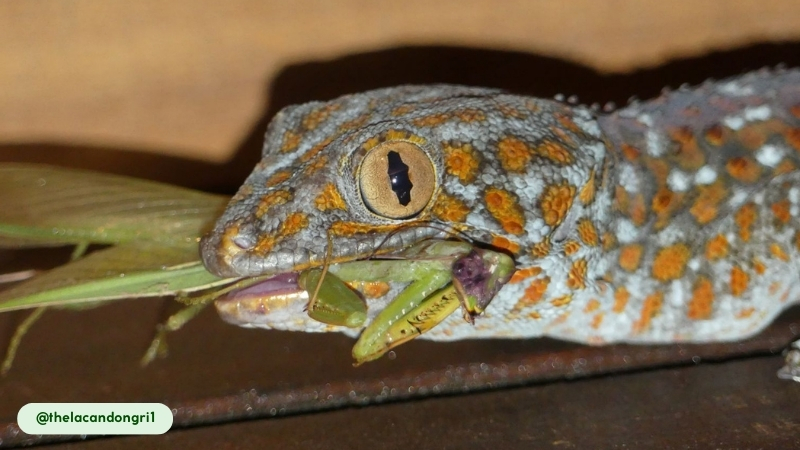
Are Tokay Geckos Endangered?
The Tokay Gecko is currently classified by the IUCN Red List as a species of “Least Concern,” a designation reflecting its broad geographic range and high population density in many areas (2). However, this classification is widely debated, with conservationists highlighting significant regional population declines. The primary threats to the species are unsustainable harvesting for the illegal exotic pet trade and traditional medicine markets, alongside habitat destruction from urbanization and deforestation (3, 12, 15).
These geckos serve a crucial ecological function as natural predators of insects, which can be highly beneficial to human communities (14). To help ensure their long-term survival, individuals can avoid purchasing wild-caught geckos and support reputable conservation organizations focused on protecting their native habitats. Their continued existence is vital for maintaining balanced ecosystems, especially in urban environments.
The conservation status of the Tokay Gecko gives us an important look at the challenges they face. With that in mind, what are some of the other amazing and lesser-known facts about this incredible species?
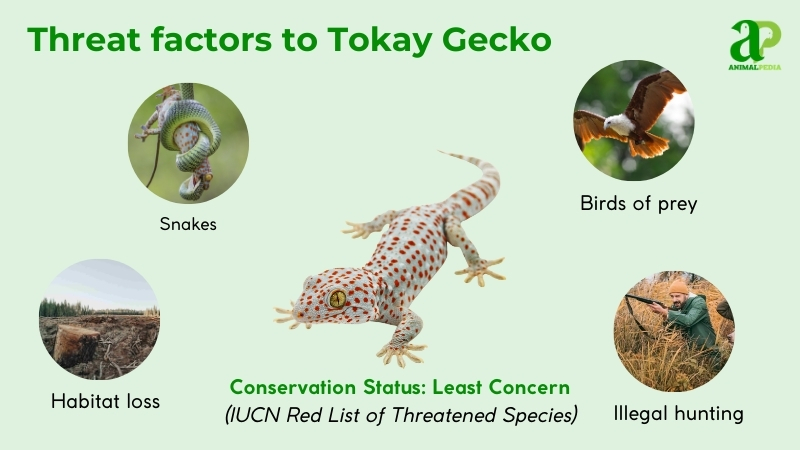
Frequently Asked Questions About Tokay Geckos
Are Tokay Geckos Invasive?
Yes, Tokay Geckos are considered an invasive species in regions outside their native habitat, such as Florida. Their aggressive nature and adaptable diet allow them to compete with and displace local wildlife, posing a significant threat to native ecosystems (6).
Are Tokay Geckos Venomous?
No, Tokay Geckos are not venomous. Their primary defense mechanism is a powerful bite, not a toxic substance. They will bite when they feel threatened, but they do not inject any venom or poison into their victims (1, 14).
Do Tokay Gecko Bites Hurt?
Yes, a Tokay Gecko’s bite can be very painful. They have exceptionally strong jaws that can exert significant pressure, capable of breaking the skin. The pain is a result of the physical force rather than any venom, and it is a defensive reaction (14, 18).
Do Tokay Geckos Change Color?
Yes, Tokay Geckos can change their coloration to better match their surroundings. This physiological trait allows them to lighten or darken their skin tone to improve their camouflage against tree bark or other surfaces, aiding in both hunting and defense (10).
Do Tokay Geckos Make Good Pets?
No, Tokay Geckos are generally not suitable pets for novice owners. Their highly aggressive and territorial temperament makes them difficult to handle, and they are known to deliver powerful, painful bites when startled or cornered. They are best suited for experienced keepers (11, 18).
Conclusion
The Tokay Gecko is defined by its formidable size, striking appearance, and complex behaviors. From its impressive climbing abilities, powered by millions of microscopic hairs, to its powerful, territorial calls and adaptable nature, this species holds a unique place in the world’s ecosystems. This comprehensive guide, built upon a foundation of scientific accuracy and detailed research, provides a definitive resource for understanding the zoological, morphological, and ecological complexities of the Tokay Gecko.
At Animal Pedia, our mission is to deliver sophisticated biological knowledge through an innovative and engaging format. We strive to transform the way people learn about the planet’s diverse fauna by providing the highest standards of scientific accuracy and educational content. If this exploration of the Tokay Gecko has piqued your curiosity, we encourage you to dive deeper into our extensive digital encyclopedia. Discover more about our world and its fascinating creatures by exploring our other species profiles, all designed to make complex biological concepts accessible to everyone.




